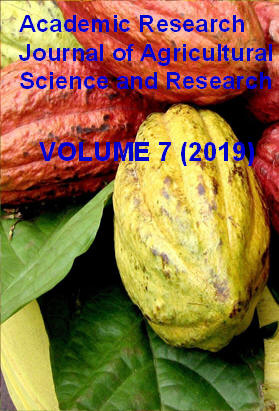|
ISSN: 2360-7874 |
Academic Research Journal of
Agricultural Science and Research |
|||||||||||||||||||
|
Vol. 7(6), pp. 333-340, September 2019 Research Determination of optimal irrigation scheduling and water productivity for wheat (Triticum aestevum L.) at Kulumsa, Arsi Zone, Ethiopia
Samuel Lindi1, Bakasho Eticha1, Mehiret Hone1, Kassu Tadesse1 and Wubengeda Admasu1
1 Kulumsa Agricultural Research Center, P.O.Box: 489, Kulumsa, Ethiopia Corresponding author's email: samuellindi5@gmail.com Accepted 31 July 2019
This study was conducted at Kulumsa Agricultural Research Center, Arsi zone, Ethiopia, for two consecutive years (2015/16 and 2016/17) to evaluate the response of wheat to irrigation regime (when and how much water to irrigate) and to determine its water requirement and productivity. The experiment was arranged in a Randomized Complete Block Design (RCBD) with three replications. The treatments included five levels of irrigation regime, which were selected based on their level of soil moisture depletion (60%, 80%, 100%, 120% and 140% of Allowable Soil Moisture Depletion Level (ASMDL)). The result revealed that ASMDL significantly (p<0.05) affected the grain yield, above ground total biological yield and water productivity of wheat. The highest grain (4,959 kg ha-1) and above ground total biological (10,734 kg ha-1) yields were obtained at 60% of ASMDL. However, these results were statistically similar to the control treatment (100% ASMDL). The minimum grain (3,823 kg ha-1) and above ground total biological (8,555 kg ha-1) yields were recorded at 140% and 120% of ASMDL, respectively. The highest water productivity (1.17 kg m-3) was obtained at 60% of ASMDL, which was statistically similar to the control treatment whereas the lowest water productivity (0.98 kg m-3) was recorded at 140% of ASMDL. The result further revealed that increasing the soil moisture depletion level from 60% to 140% of the FAO recommendation had no effect on plant height, hectoliter weight, kernel weight and harvesting index of wheat. Having considered the non-significant difference between the control treatment (100% of ASMDL) and 60% of ASMDL with respect to wheat yield and its water productivity, irrigation at 100% of ASMDL has been recommended for wheat production at the study area and other areas with similar agro-ecology and soil type due to the fact that the irrigation interval of the 100% of ASMDL is longer compared to the 60% of ASMDL.
Keywords: irrigation scheduling, soil moisture depletion, water productivity and wheat
How to cite this article (APA Style): Samuel L., Bakasho I., Mehiret H., Kassu T., Wubengida A. (2019). Determination of Optimal Irrigation Scheduling and Water Productivity for Wheat (Triticum aestevum L.) at Kulumsa, Arsi Zone, Ethiopia. Acad. Res. J. Agri. Sci. Res. 7(6): 333-340
|
|||||||||||||||||||
